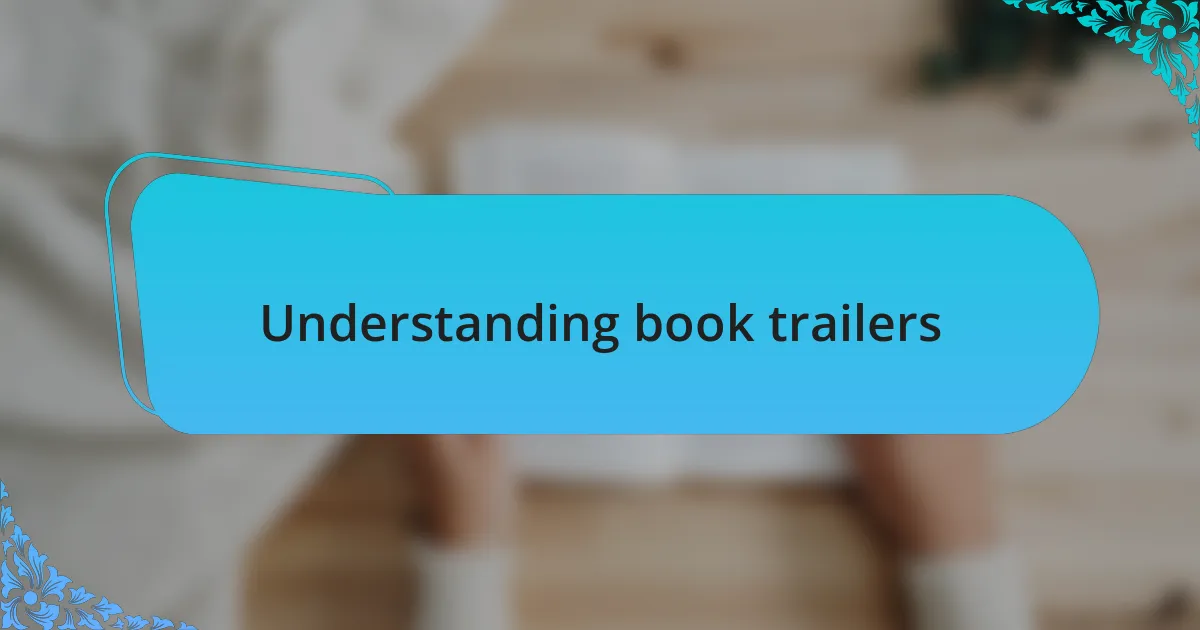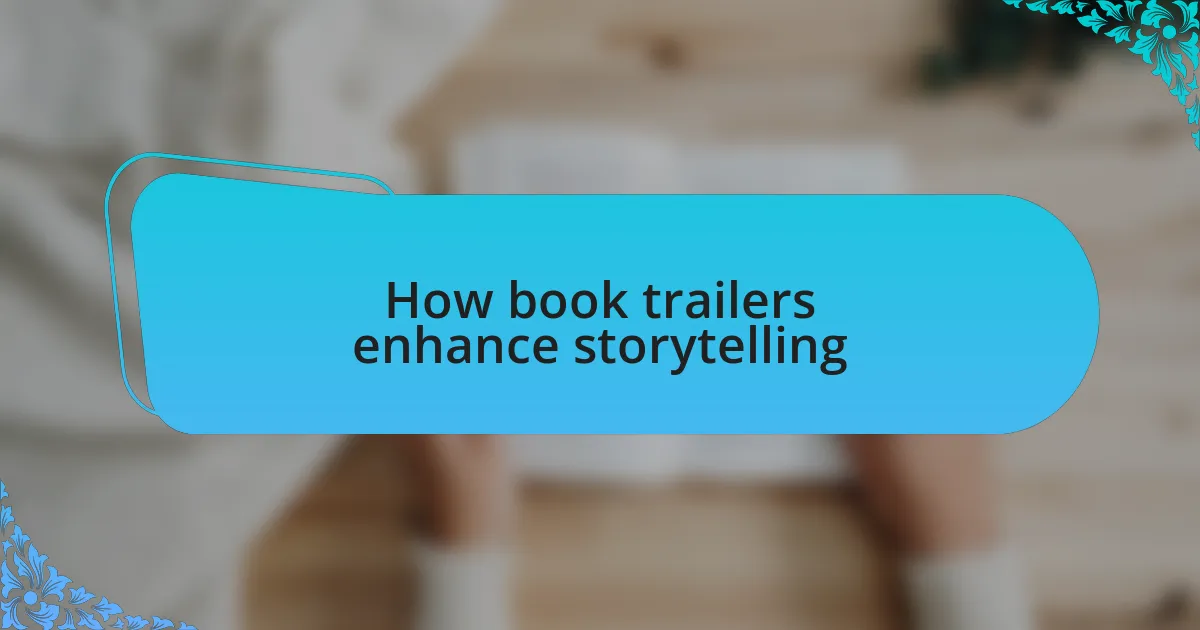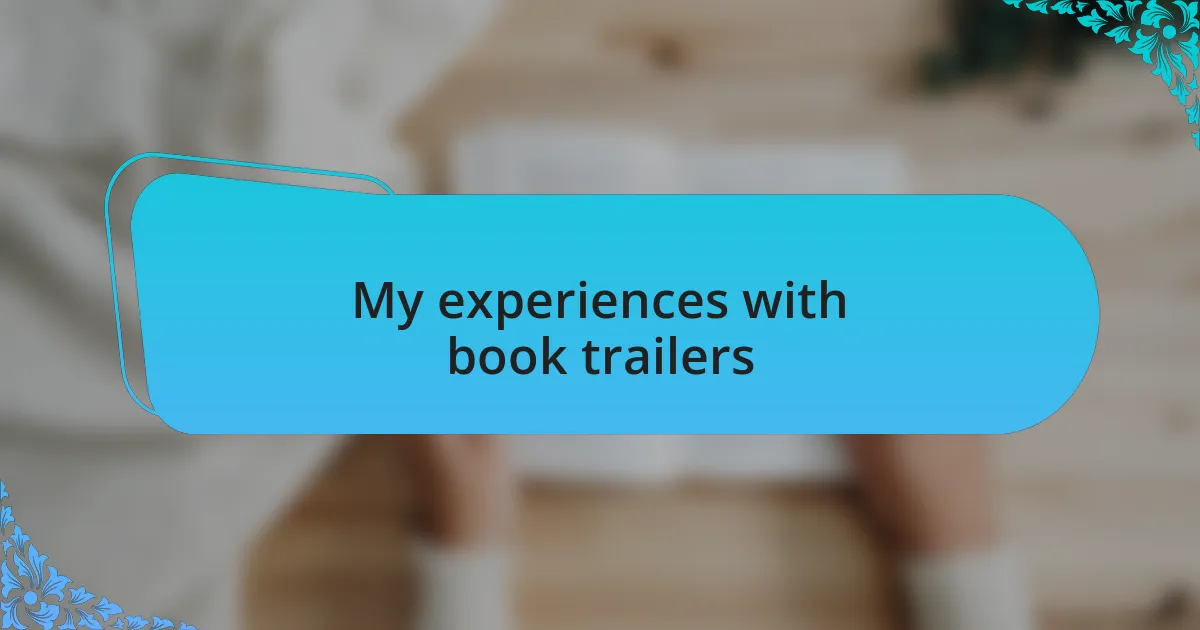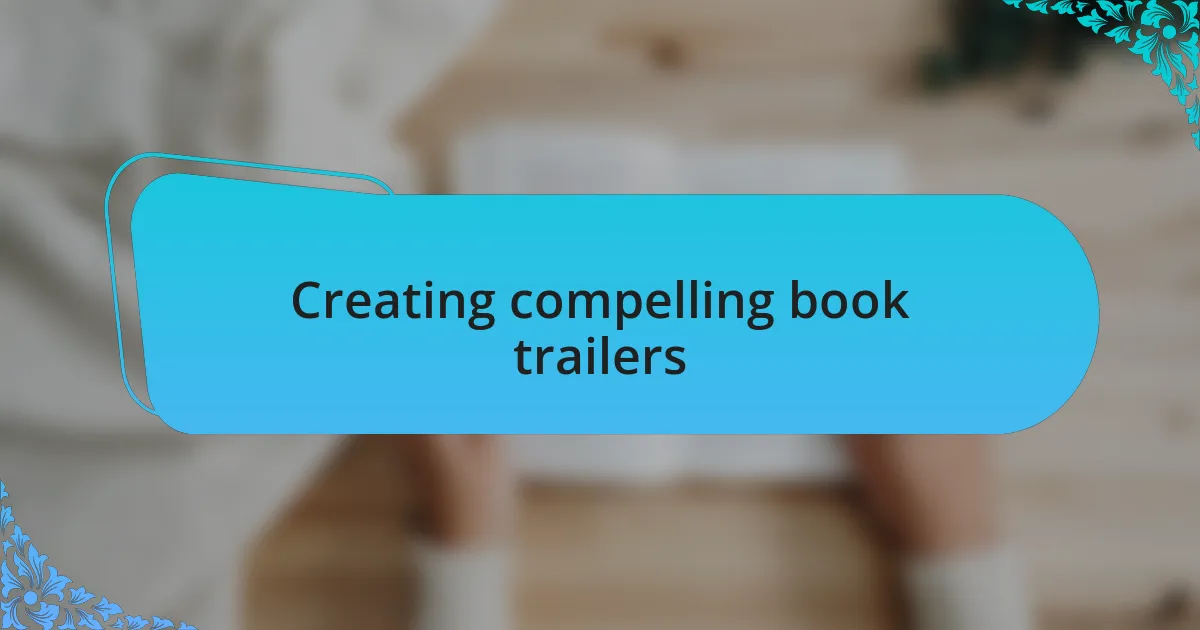Key takeaways:
- Book trailers blend audio-visual elements to create emotional connections and spark curiosity, serving as innovative marketing tools.
- They encourage deeper engagement with narratives and can expand an author’s reach, helping readers discover hidden gems.
- Effective trailers incorporate strong visual storytelling, sound design, and thought-provoking content to resonate with the audience.
- Key elements for successful book trailers include clarity, pacing, and showcasing relatable characters to foster viewer connections.

Understanding book trailers
Book trailers serve as visual invitations to the world of literature, transforming the way we engage with stories. They combine audio-visual elements to convey the essence of a book, often igniting curiosity and emotion. I remember the first time I watched a book trailer; it was for a fantasy novel that swept me off my feet, making me yearn to dive into its pages.
Have you ever felt a rush of anticipation from a well-crafted trailer? That’s the power of this medium—it’s not just about summarizing a plot but about creating an atmosphere. A good book trailer elicits feelings that resonate with potential readers, like when I found myself moved by dramatic imagery and an evocative soundtrack, compelling me to explore the book further.
In essence, book trailers are an innovative marketing tool that can make or break a reader’s interest. They distill the narrative into a short, stimulating format, raising questions that linger just long enough to entice viewers. I’m convinced that when done right, a book trailer can illuminate the heart of a story and create a connection that words alone often struggle to achieve.

Importance of book trailers
Book trailers hold a unique place in the literary world; they are not merely promotional tools, but rather gateways to deeper engagement with stories. I recall seeing a trailer for a historical novel, and the vibrant visuals paired with haunting music transported me right into the setting. It made me ponder how effectively a minute of video could encapsulate the essence of months spent crafting a narrative.
The importance of book trailers lies in their ability to evoke emotion and curiosity almost instantaneously. Remember the last time you watched a captivating trailer and found yourself wanting to know more? A well-executed trailer can create that same feeling of excitement, encouraging readers to take the plunge into unfamiliar literary waters. I often find myself connecting with books I might have overlooked simply because the visuals sparked a connection.
Moreover, these trailers can expand a book’s reach far beyond traditional marketing. I’ve seen lesser-known authors gain a substantial following simply because their trailer caught the eye of a viewer on social media. It’s as if the trailer serves as a bridge, helping readers discover hidden gems that might otherwise fade into the background. In today’s fast-paced world, where attention spans are fleeting, book trailers might just be the hook that draws in a reader.

How book trailers enhance storytelling
Book trailers can elevate storytelling by blending visuals, sound, and text to create a sensory experience that words alone often can’t convey. I remember watching a trailer for a fantasy novel where the stunning landscapes and fitting soundtrack brought the world to life in ways the written description never could. It made me wonder: how often do we overlook the power of imagery in storytelling, and how much can a well-crafted visual narrative enhance our understanding of a book’s themes and characters?
These brief glimpses into a story can also ignite the reader’s imagination. Just recently, I viewed a trailer that featured poignant quotes from the book, interspersed with dynamic imagery. It made me reflect on the emotional undertones of the narrative before I even cracked open the cover. Isn’t it fascinating how a few seconds of carefully curated footage can spark deep connections and resonate with our own life experiences?
Furthermore, book trailers often encapsulate the mood of a story, giving potential readers a taste of what they can expect. I recall a trailer that perfectly mirrored the anxious tension found within a psychological thriller. Watching it made my heart race, compelling me to delve into the pages immediately. It’s intriguing to think about the synergy between visual elements and literary themes, shaping the way we approach and appreciate the stories that await us.

Viewing trends at literary festivals
At literary festivals, I’ve noticed a remarkable shift in viewing trends, especially in how much people engage with digital content. During a recent event, I attended a panel where an author presented their book trailer. The audience was instantly captivated; it struck me how this visual medium drew more attention than traditional readings. Isn’t it intriguing how images and sound can create an immediate connection to a story, sometimes even more effectively than words?
Moreover, attendees often flock to interactive displays featuring book trailers, showing an increasing appreciation for immersive experiences. I remember standing in front of one such display, where a trailer played on a large screen, surrounded by the buzz of fellow festival-goers. The atmosphere was lively, and it was clear that the trailer not only thrilled viewers but also sparked conversations among them about the book’s themes. How can we ignore this powerful trend that blends technology and literature so seamlessly?
Interestingly, I’ve observed that book trailers serve more than just promotional purposes; they engage audiences in ways that foster community. I saw groups huddled together, sharing their thoughts after watching a trailer, as if they were discussing a movie rather than a book. It’s remarkable how a few minutes of visual storytelling can unite readers and create a sense of anticipation for upcoming releases. This trend makes me wonder: how might the future of reading evolve as these digital experiences continue to shape our literary discussions?

My experiences with book trailers
When I first encountered a book trailer at a festival, I was skeptical. I remember standing in front of a screen, arms crossed, wondering how a brief video could convey the depth of a novel. Yet, within moments, I found myself immersed in a world that felt both captivating and inviting; the soundtrack stirred my emotions, and suddenly, my anticipation for the book skyrocketed. Isn’t it fascinating how a few minutes of footage can evoke such a strong desire to dive into a story?
One particular experience that stands out involved a hauntingly beautiful trailer for a gothic novel. As I watched the visuals unfold, I could feel a chill run down my spine. The combination of eerie music and striking imagery transported me into the author’s dark world. I almost felt as if I was part of the story itself. Have you ever had a moment where you felt the weight of a narrative lifting off the screen and wrapping around you? These moments linger in your mind, and they make you eager to explore the pages that follow.
In discussions with fellow readers after viewing a trailer, I noticed something profound—there was an energy in the air that I hadn’t experienced with traditional promotions. Each conversation sparked new insights and interpretations. I remember chatting with a passionate reader who appreciated a specific scene from the trailer, which led us down a rabbit hole of theories about character motivations. Isn’t it amazing how a simple video can ignite such rich conversations, bridging the gap between readers and deepening our connection to literature?

Creating compelling book trailers
Creating a compelling book trailer often starts with a strong visual narrative. I’ve learned that even the most stunning images need to be paired with a poignant story arc to resonate with viewers. For instance, I once saw a trailer that cleverly used a single, continuous shot to introduce the main character’s emotional turmoil. It left me wondering—how could one moment encapsulate an entire journey? That’s the magic of a well-crafted trailer; it invites us in while leaving us craving more.
Sound design is another critical element that can elevate a book trailer. I recall a trailer that featured an almost whispering narration layered over an instrumental score, creating an intimate atmosphere. It was as if the narrator was sharing a secret meant only for me. That right blend of audio and visuals can evoke emotions, pulling us deeper into the book’s essence. Have you ever noticed how certain sounds can remind you of the themes in a story, establishing an emotional connection before you’ve even turned a page?
Lastly, engaging the audience with a thought-provoking question or a compelling quote from the book can create a lasting impression. One time, a trailer concluded with a striking line that lingered in my mind long after the credits rolled. It made me pause and reflect on my views about the story. What if more trailers ended with a challenge or a philosophical question? This approach could not only hook viewers but also prompt them to consider the broader implications of the story, enhancing their eagerness to experience it firsthand.

Tips for effective book trailers
When crafting a book trailer, clarity should be a top priority. I remember watching a trailer that was visually stunning but left me confused about the story’s premise. It hit me hard—if viewers can’t grasp the essence of the book in those fleeting seconds, what’s the point? Clearly highlighting the genre and central conflict helps to create a mental hook for potential readers.
Another effective strategy involves the use of pacing. I once came across a trailer that expertly built tension before revealing its main conflict. This deliberate slow build made me lean in closer, hanging on every word. Have you considered how the rhythm in your trailer could evoke urgency or intrigue? A well-timed crescendo can transform mere visuals into a gripping experience, making viewers eager to dive into the narrative.
Lastly, showcasing relatable characters through snippets of dialogue or action can foster a connection. I vividly recall feeling an instant bond with a character who expressed a sentiment that mirrored my own. This identification can be powerful—if viewers see parts of themselves reflected in the characters, they’re likely more inclined to pick up the book. Isn’t it fascinating how a glimpse into a character’s world can make the entire story feel more personal?